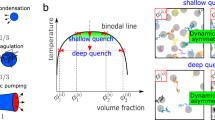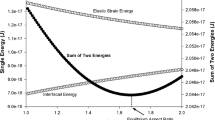Abstract
The recently developed void expansion method (VEM) allows for an efficient generation of porous packings of spherical particles over a wide range of volume fractions. The method is based on a random placement of the structural particles under addition of much smaller “void-particles” whose radii are repeatedly increased during the void expansion. Thereby, they rearrange the structural particles until formation of a dense particle packing and introduce local heterogeneities in the structure. In this paper, microstructures with volume fractions between 0.4 and 0.6 produced by VEM are analyzed with respect to their degree of heterogeneity (DOH). In particular, the influence of the void- to structural particle number ratio, which constitutes a principal VEM-parameter, on the DOH is studied. The DOH is quantified using the pore size distribution, the Voronoi volume distribution and the density-fluctuation method in conjunction with fit functions or integral measures. This analysis has revealed that for volume fractions between 0.4 and 0.55 the void-particle number allows for a quasi-continuous adjustment of the DOH. Additionally, the DOH-range of VEM-generated microstructures with a volume fraction of 0.4 is compared to the range covered by microstructures generated using previous Brownian dynamics simulations, which represent the structure of coagulated colloidal suspensions. Both sets of microstructures cover similarly broad and overlapping DOH-ranges, which allows concluding that VEM is an efficient method to stochastically reproduce colloidal microstructures with varying DOH.
Similar content being viewed by others
References
Yun T.S., Santamarina J.C., Ruppel C.: Mechanical properties of sand, silt and clay containing tetrahydrofuran hydrate. J. Geophys. Res. 112, B04106 (2007)
Touiti L., Bouassida M., Van Impe W.: Discussion on Tunis soft soil sensitivity. Geotech. Geol. Eng. 27(5), 631–643 (2009)
Mezzenga R., Schurtenberger P., Burbidge A., Michel M.: Understanding foods as soft materials. Nat. Mater. 4, 729–740 (2005)
Barbesta F., Bousfield D.W., Rigdahl M.: Modeling of rheological properties of coating colors. J. Rheol. 45(1), 139–160 (2001)
Lee Y.S., Wagner N.J.: Dynamic properties of shear thickening colloidal suspensions. Rheol. Acta 42(3), 199–208 (2003)
Barnes H.A.: Thixotropy–a review. J. Non-Newtonian Fluid Mech. 70, 1–33 (1997)
Abou B., Bonn D., Meunier J.: Aging dynamics in a colloidal glass. Phys. Rev. E 64(2), 021510 (2001)
Zaccone A., Lattuada M., Wu H., Morbidelli M.: Theoretical elastic moduli for disordered packings of interconnected spheres. J. Chem. Phys. 127(17), 174512 (2007)
Gardiner B.S., Tordesillas A.: Effect of particle size distribution in a three-dimensional micropolar continuum model of granular media. Powder Technol. 161(2), 110–121 (2006)
Silbert L.E., Ertaş D., Grest G.S., Halsey T.C., Levine D.: Geometry of frictionless and frictional sphere packings. Phys. Rev. E 65(3), 031304 (2002)
Martin C.L., Bordia R.K.: Influence of adhesion and friction on the geometry of packings of spherical particles. Phys. Rev. E 77(3), 031307 (2008)
Atman A.P.F., Brunet P., Geng J., Reydellet G., Combe G., Claudin P., Behringer R.P., Clément E.: Sensitivity of the stress response function to packing preparation. J. Phys. Condens. Matter 17, S2391–S2403 (2005)
Franks G.V., Zhou Y., Yan Y., Jameson G., Biggs S.: Effect of aggregate size on sediment bed rheological properties. Phys. Chem. Chem. Phys. 6(18), 4490–4498 (2004)
Wyss H.M., Tervoort E.V., Gauckler L.J.: Mechanics and microstructures of concentrated particle gels. J. Am. Ceram. Soc. 88(9), 2337–2348 (2005)
Wyss H.M., Tervoort E., Meier L.P., Müller M., Gauckler L.J.: Relation between microstructure and mechanical behavior of concentrated silica gels. J. Colloid Interface Sci. 273(2), 455–462 (2004)
Wyss H.M., Deliormanli A.M., Tervoort E., Gauckler L.J.: Influence of microstructure on the rheological behavior of dense particle gels. AIChE J. 51(1), 134–141 (2005)
Gauckler L.J., Graule Th., Baader F.: Ceramic forming using enzyme catalyzed reactions. Mater. Chem. Phys. 61(1), 78–102 (1999)
Tervoort E., Tervoort T.A., Gauckler L.J.: Chemical aspects of direct coagulation casting of alumina suspensions. J. Am. Ceram. Soc. 87(8), 1530–1535 (2004)
Hesselbarth D., Tervoort E., Urban C., Gauckler L.J.: Mechanical properties of coagulated wet particle networks with alkali-swellable thickeners. J. Am. Ceram. Soc. 84(8), 1689–1695 (2001)
Agnolin I., Roux J.-N.: Internal states of model isotropic granular packings. I. Assembling process, geometry and contact networks. Phys. Rev. E 76(1), 061302 (2007)
Jerkins M., Schröter M., Swinney H.L., Senden T.J., Saadatfar M., Aste T.: Onset of mechanical stability in random packings of frictional spheres. Phys. Rev. Lett. 101(1), 018301 (2008)
Bagi K.: An algorithm to generate random dense arrangements for discrete element simulations of granular assemblies. Granul. Matter 7(1), 31–43 (2005)
Luding, S.: Contact models for very loose granular materials. In: Eberhard, P. (ed.) Symposium on Multiscale Problems in Multibody System Contacts, pp. 135–150. Springer, Heidelberg, ISBN 978-1-4020-5980-3 (2007)
Schenker I., Filser F.T., Herrmann H.J., Gauckler L.J.: Generation of porous particle structures using the void expansion method. Granul. Matter 11(3), 201–208 (2009)
Schenker I., Filser F.T., Aste T., Herrmann H.J., Gauckler L.J.: Quantification of the heterogeneity of particle packings. Phys. Rev. E 80(2), 021302 (2009)
Hütter M.: Local structure evolution in particle network formation studied by Brownian dynamics simulation. J. Colloid Interface Sci. 231(2), 337–350 (2000)
Hütter, M.: Brownian dynamics simulation of stable and of coagulating colloids in aqueous suspension, Ph.D. thesis no. 13107, ETH Zurich, Switzerland (1999)
Russel, W.B., Saville, D.A., Schowalter, W.R.: Colloidal dispersions, Cambridge University Press, New York (March 1989)
PFC3D User’s Manual, Itasca Consulting Group, Inc., Minneapolis, Minnesota, USA (1995)
Cundall P.A., Strack O.D.L.: A discrete numerical model for granular assemblies. Géotechnique 29(1), 47–65 (1979)
Brown E.T.: Analytical and Computational Methods in Engineering Rock Mechanics, Ed. Allen & Unwin, London (1987)
Song C., Wang P., Makse H.A.: A phase diagram for jammed matter. Nature 453(29), 629–632 (2008)
Torquato S., Lu B., Rubinstein J.: Nearest-neighbor distribution functions in many-body systems. Phys. Rev. A 41(4), 2059–2075 (1990)
Voronoi G.: Recherches sur les paralléloèdres primitives. J. Reine Angew. Math. 134, 198–287 (1908)
Barber C.B., Dobkin D.P., Huhdanpaa H.: The quickhull algorithm for convex hulls. ACM Trans. Math. Softw. 22(4), 469–483 (1996)
Aste T., Di Matteo T.: Emergence of Gamma distributions in granular materials and packing models. Phys. Rev. E 77(2), 021309 (2008)
Anikeenko A.V., Medvedev N.N., Aste T.: Structural and entropic insights into the nature of the random-close-packing limit. Phys. Rev. E 77(3), 031101 (2008)
Aste T., Di Matteo T.: Structural transitions in granular packs: statistical mechanics and statistical geometry investigations. Eur. Phys. J. B 64, 511–517 (2008)
Author information
Authors and Affiliations
Corresponding author
Rights and permissions
About this article
Cite this article
Schenker, I., Filser, F.T. & Gauckler, L.J. Stochastic generation of particle structures with controlled degree of heterogeneity. Granular Matter 12, 437–446 (2010). https://doi.org/10.1007/s10035-010-0188-5
Received:
Published:
Issue Date:
DOI: https://doi.org/10.1007/s10035-010-0188-5




